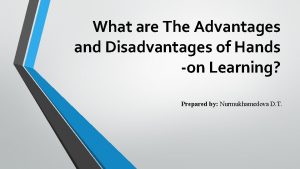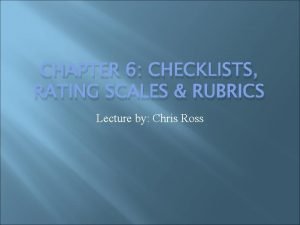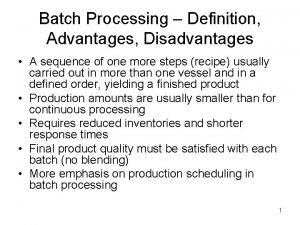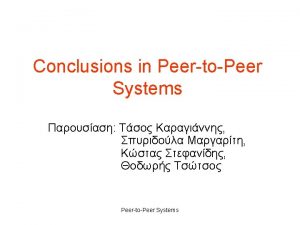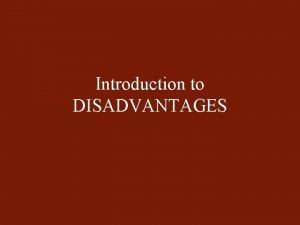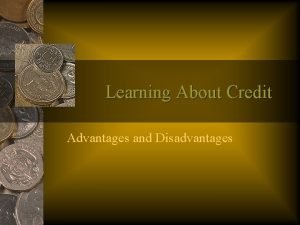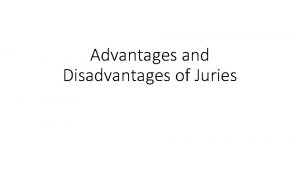What are The Advantages and Disadvantages of Hands










- Slides: 10

What are The Advantages and Disadvantages of Hands -on Learning? Prepared by: Nurmukhamedova D. T.

What is a Hands-on Learning? • Hands-on learning is an educational method that directly involves the learner, by actively encouraging them to do something in order to learn about it. In short, it is 'learning by doing'. But is it an effective way to learn, or simply a fad? This article outlines some of the main advantages and disadvantages of hands-on learning.

Advantages of Hands-on Learning? • First and foremost, it is clear that there are certain situations in which hands-on learning is the only way to teach something. For example, there is no use trying to teach a child to ride a bicycle in a traditional classroom - they need to get outside to try out a bike. Many people argue that doing something is the best way to learn about it, rather than attempting to learn about it from a book. No matter how many books you read about cycling, you are still sure to fall off the first time you try!

• Furthermore, hands-on learning allows students to directly observe and understand what is happening. This is a particularly successful way to teach kinesthetic learners, who learn best by example. It is often hard to properly understand something you have never directly seen or experienced. This is why lately hands-on learning has become more popular in education - there are more vocational courses that provide work experience than ever before. This is a perfect example on hands-on learning in practice.

It also encourages young pupils to do things for themselves, which will help them with learning independently later on in life. Important life skills such as these are often neglected in a situation where students are simply told facts and made to learn them by heart.

Learning styles are often categorized and explained in the following way: • Visual: You learn well when aided by images, pictures, and spatial organization of elements • Auditory: You learn well when aided by music, sound, rhyme, rhythm, speaking or listening • Reading/Writing: You learn well by reading or writing the material you want to learn • Kinesthetic: You learn well when you can move your body, and/or use your hands and sense of touch. Writing or drawing diagrams are physical activities that can fall into this category as well. These categories of learning styles were identified by Dr. Neil Fleming in the late ’ 80 s, and represent The VARK model of learning styles. Other educators and researchers have identified additional learning styles, with some models showing as many as 70 different styles.

VARK learning styles by Dr. Neil Fleming

Disadvantages of Hands-on Learning? However, there are downsides to the technique. Often demonstrations will give students the main idea of how something works, but place less emphasis on detail. For students hoping to attain the highest grades, they may need to read up on their subject to develop a deeper understanding of it. Students may feel after learning the basics they don't need to do any more study, which could impact negatively on their grades.

Some things simply can't be taught using hands-on learning. For example, complex algebra - the best way to teach this is in lecture based classes, as there are few practical demonstrations that can be done to help students understand it. Other topics may be hard to cover because of high costs - like space rockets; very few schools are able to go and visit a space center. This could increase the apartheid between state and private schools, as private schools are more likely to be able to afford expensive visits and equipment, which disadvantages students who are less well off.

Conclusion There is no doubt that actively involving students will enhance their education. However, hands-on learning would be more effective if it was combined with traditional learning from books. Although it is very good at providing a foundation for knowledge and understanding, in some cases it fails to develop ideas to a higher level.
 Insidan region jh
Insidan region jh Hands up hands down
Hands up hands down Disadvantages of hands-on learning
Disadvantages of hands-on learning Point-to-point airline advantages and disadvantages
Point-to-point airline advantages and disadvantages Define braze welding
Define braze welding Confederate advantages
Confederate advantages Manual input devices
Manual input devices Plate and frame filter advantages and disadvantages
Plate and frame filter advantages and disadvantages Through and through timber conversion
Through and through timber conversion Advantages and disadvantages of checklists and rubrics
Advantages and disadvantages of checklists and rubrics Advantages of batch processing
Advantages of batch processing


